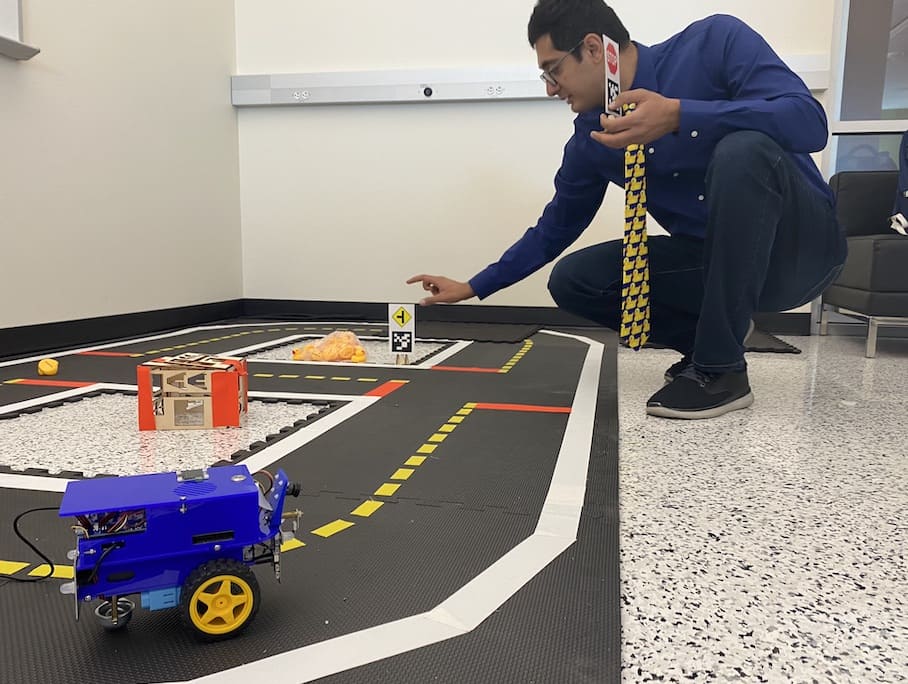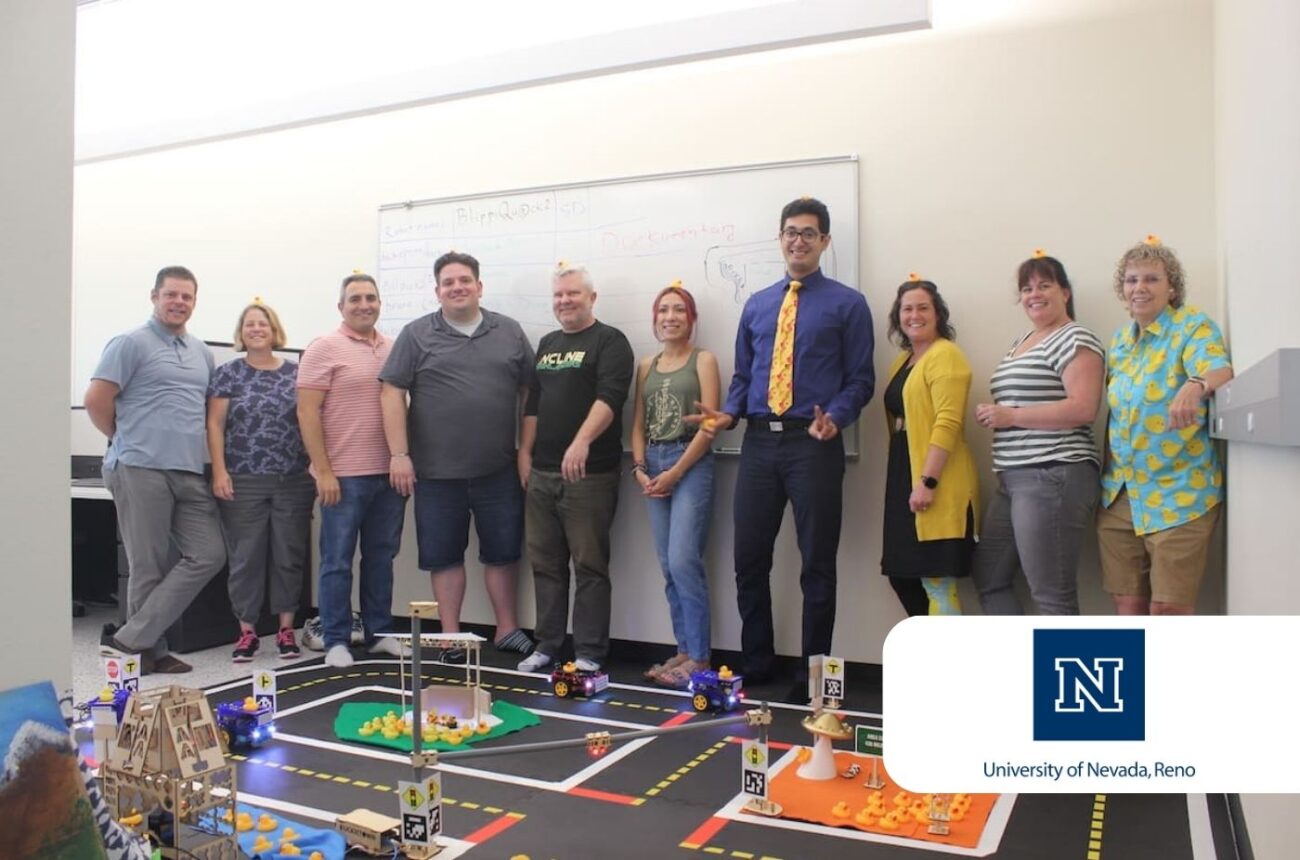
Category: outreach


Kicking off the Duckietown Donation program with Cali, Colombia

We’ve reached our Kickstarter goal!
This is great news because it means that we can kick off our donation program, with our first donation of a Class Kit, to students at the Universidad Autónoma de Occidente in Cali, Colombia.

Why a donation program?
Artificial Intelligence and Robotics are the sciences of the future, which is why we want everyone to have the chance to play and learn with Duckietown. While we design our robot platform to be as inexpensive as possible, we realize that cost might be an obstacle for educators or students with limited resources.
That is why we have designed a donation program where individuals, organizations or companies can make Duckietown truly accessible to all. Everybody can support STEM education by donating Duckiebots, or an entire Class Kit, to deserving individuals or educators.
Our first recipient

Our first recipient is Prof. Victor Romero Cano, a professor from the Universidad Autónoma de Occidente in Cali, Colombia.
Victor has a Ph.D. in field robotics obtained at the University of Sydney, Australia. He teaches two courses at his institution, and supervises over 40 undergraduate students who are working towards their final research projects.
Victor will teach two classes using the Duckietown platform. The first is an introductory class to robotics, covering kinematic analysis, teleoperation, control and autonomous navigation for wheeled robots. The second class is more specifically about robotic perception, and will go in detail about mapping and SLAM (simultaneous localization and mapping), covering lane detection as well as object detection, recognition and tracking.
Victor’s first Duckietown class starts in January 2019. We welcome him to the community and look forward to hearing about his journey!
You can help us sponsor more donations by sponsoring our Kickstarter.

Duckietown in Ghana – Teaching robotics to brilliant students
July 2018: Vincent Mai travels from Canada to teach a 2-week Duckietown class to some of the brightest high school students in Ghana.
The email – Montreal, January 2018
On the morning of January 29th, 2018, I received an email. It was a call for international researchers to mentor for two weeks a small group of teenagers that will have been selected among the brightest of Ghana. Robotics was one of the possible topics.
At 4 pm, I had applied.
I was lucky enough to grow up in a part of the world where sciences are available to children. I spent summers in Polytechnique Montreal, playing with electro-magnets and making rockets fly with vinegar and baking soda. I also remember visiting the MIT Museum in Boston, where I was impressed by the bio-inspired swimming robots. There is no doubt that these activities encouraged 17-years-old me to choose physics engineering as my bachelor studies, which then turned into robotics at the graduate level.
The MISE Foundation
The call from the MISE Foundation was a triple opportunity.
First, I could transmit the passion I was given when I was their age. Second, I would participate, in my small, modest way, in the reduction of education inequalities between developing an developed countries. Countries like Ghana can only benefit from brilliant Ghanaians considering maths, computer science or robotics as a career.
Finally, it was an unique opportunity for me to discover and learn, from people living in an environment that is totally different from mine, with other values, objectives and challenges. It is not everyday you can spend two weeks in Ghana.
After some exchanges with Joel, the organizer, with motivation letters, project plan and visa paperwork, it was decided: I was going to Accra from July 20th to August 6th.
The preparation – Montreal, June 2018
My specialty is working with autonomous mobile robots: this is what I wanted to teach. I was going to see the brightest young minds of a whole country. I needed to challenge them: I could not go there with a drag-and-drop programmed Lego.
I chose an option that was close to me. Duckietown is a project-based graduate course given at Université de Montréal by my PhD supervisor, Prof. Liam Paull. It allows students to learn the challenges of autonomous vehicles by having miniature cars run in a controlled environment. A Duckiebot is a simple 2-wheel car commanded by a Raspberry Pi. Its only sensor is a camera.
Along with my proximity with Duckietown, I chose it because making a Duckiebot drive autonomously is a very concrete problem, which involves a lot of interesting concepts: computer vision, localization, control, and integration of all these on a controller. Also, for teenagers, the Duckie is a great mascot.
I had not yet taken the Duckietown course. Preparing took me one month and a half of installing, reverse engineering, and documenting. The objective I designed for the kids? Having a Duckiebot named Moose follow the lanes with a constant speed, without getting out of the road or crossing the middle line.
It was inspired from a demo that was already implemented in the Duckiebot. I could not ask the kids to implement the whole code, so I cut out only the most critical parts of it. I also wrote presentations, exercises, planning each of the 10 days we would spend together, 6 hours a day. I packed the sport mats to do the road, a couple of extra pieces in case something broke, and the print-outs of the presentations. I was ready.
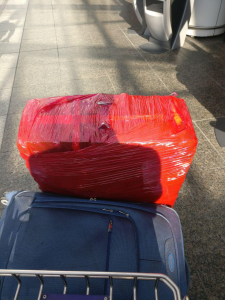
Packed Duckietown
Or, I hoped I was. It was not simple to adapt the contents of a graduate course for kids of whom I had no idea of the math and programming level. Did they know how to multiply matrices? What about Bayes law? Can I ask them to use Numpy? When I asked advice to Liam, he told me with a smile: “I guess you’ll have to take the go with the flow…”
The building – Accra, August 2018
Accra is a large city, spread along the shore of the Atlantic Ocean. Its people are particularly smiling and welcoming. The Lincoln Community School, a private institution hosting the MISE Foundation summer school, has beautiful and calm facilities which allowed us to give the classes in a proper environment. There were 24 children in total: 12 were training for the International Maths Olympics with two mentors, while three teams of 4 students would work with a mentor on projects like mine. The two other projects were adversarial attacks on image classifiers and stereo vision.
The first two days, we did maths. I tested their level: they did not know most of what was necessary to go on. Vector operations, integrals, probabilities… We went through these in a very short time: they amazed me by the speed at which they understood.
We followed with the real project: autonomous mobile robotics.
-
See-Think-Act cycle;
-
computer vision for line extraction, from RGB images to Canny edge detection and Hough transform;
-
camera calibration for ground projection, from image sensors to homography matrix;
-
Bayesian estimator for localization, with dynamic prediction and measurement update;
-
and finally, proportional control for outputting the right commands to the wheels.
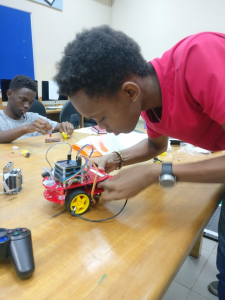
Building Moose
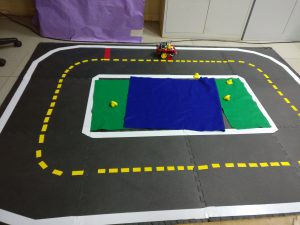 Moose the Duckiebot, up and running!
Moose the Duckiebot, up and running!
The experiments – Accra, August 2018
In the two next days, the students had to think what they would do for their research projects. The experiments would be done together but the projects should be individual. Each of them decided to focus on one aspect of autonomous cars. Kwadwo decided to go for speed: he tested the limits of the car as if it was an autonomous ambulance. Abrahim was more concerned about safety: was Moose better than humans at driving? Oheneba thought about the reduction glasshouse gas emissions and William about lowering the traffic. In both cases, they argued that if autonomous cars could improve the situation, they first had to be accepted by humans and therefore be safe and reliable. They tested Moose in differently lit scenes, with white sheets on the road (snow) or with a slightly wrong wheel calibration, to see how it would cope with these conditions.
On the last day, they individually presented their research to a committee formed by the three project mentors. We asked them difficult questions for 15 minutes, testing them and pushing them to think above what they had learned in these 2 weeks. We judged them based on the Intel ISEF criteria (Research project, Methodology, Execution, Creativity and Presentation).
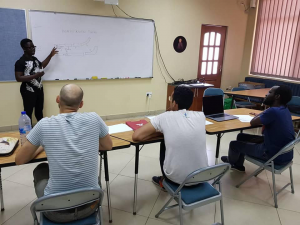 Presenting in front of the judging committee
Presenting in front of the judging committee
The closing ceremony – Accra, August 2018
Saturday was parents day. The students made a general presentation of their projects, making the parents laugh uneasily every time they asked “Is everything clear?” At least, I think most of the parents enjoyed the demonstration: it is always nice to see a Duckiebot run!
Finally, at the closing ceremony, the students who had the best presentation grades were rewarded. I was proud that Kwadwo was named Scholar of the Year, winning a Mobile Robotics book and the right to represent Ghana at the Intel ISEF conference in Phoenix, Arizona, in May 2019. He will present his project with the Duckiebot!
The students and organizers also gave each of us a beautiful gift: a honorary scarf on which it is written “Ayeekoo”. In the local languages, it means: “Job well done.”
I hope I did my job well, and that William, Oheneba, Kwadwo and Abrahim will remember Moose the Duckiebot when they choose their careers. I know that, in any case, these four brilliant young men will continue to shine. On my side, I really enjoyed the experience. I will make sure I don’t miss an opportunity to teach again to teenagers using Duckietown, whether it is in another country or here, in Montreal.
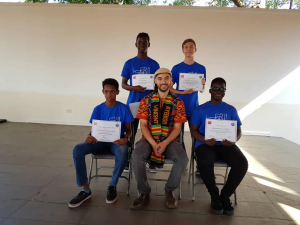 The best team!
The best team!
Important note
I had four boys in my group. You can notice on the picture below that, out of the 24 students, only 3 girls participated in the MISE Foundation program. When I asked Joel about it, he told me he has a very difficult time getting women to participate. At least 6 more girls were invited, but their parents would pressure them not to do maths and science, and discourage them from going to the Summer School. They feel this is not what a woman should be doing. I find this situation very frustrating. Ghana is a country with strong family values that are different from the ones I am used to. It is not our role as international researchers to tell them what is good and what is not. And, to be fair, software engineering presents similar ratios in Canada, even if the reasons are less tangible (maybe?).
On the other hand, engineers and scientists build the world around us, and they do so according to the needs they feel. Men cannot build everything women need. I strongly encourage any girl, in any country, who reads this blog post and who is interested about maths and computer science, to stand for what they want to do. We need you here, to build tomorrow’s world together.
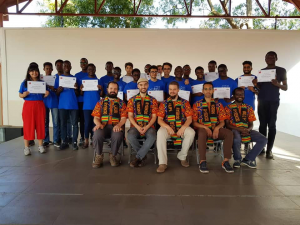 MISE 2018 – Ayeekoo!
MISE 2018 – Ayeekoo!
Tell us your story
Are you an instructor, learner, researcher or professional with a Duckietown story to tell? Reach out to us!

How Duckietown inspired a 14 year old girl to become a tech entrepreneur
We host a guest post by Valeria Cagnina, who had the luck to meet our team very early – in fact, when the first Duckietown was still being built – and she helped with the tape!
Nothing is impossible…the word itself says “I’m possible”!
I discovered robotics when I was 11 years old with a digital plant made with Arduino that I saw in Milan Coderdojo. I really liked robotics and decided I would like to make my own robot.
So I searched online for a robot I could make myself. I found some videos on the web about a robot from MIT. I really loved this wonderful robot… but I was too young and I didn’t have the skills necessary to build it. So I surfed online to search other types that would be easier to build, but in my mind remained the dream to go to see this cool robot at MIT in Boston.
After a while, following and making my own Youtube videos, I made my first robot alone at 11 years old: it could move itself around a room avoiding obstacles thanks to its distance sensor programming with Arduino.
In Italy it was not so common to make a robot at 11, so I was able to share this experience a lot of events and conferences that brought me to speak in a TEDx at 14 years old.
Casually, at the same age, I travelled to United States to visit New York, Boston and Canada… at the beginning it seemed a normal holiday…
I convinced my parents to extend our trip to stay more time around MIT. We went sightseeing in Boston and in MIT but it wasn’t enough for me! I wanted to look inside this place that was so magical to me, and I especially wanted to talk with the engineers that build and program robots! Maybe I would see that same robot that I found when I was 11 years old!
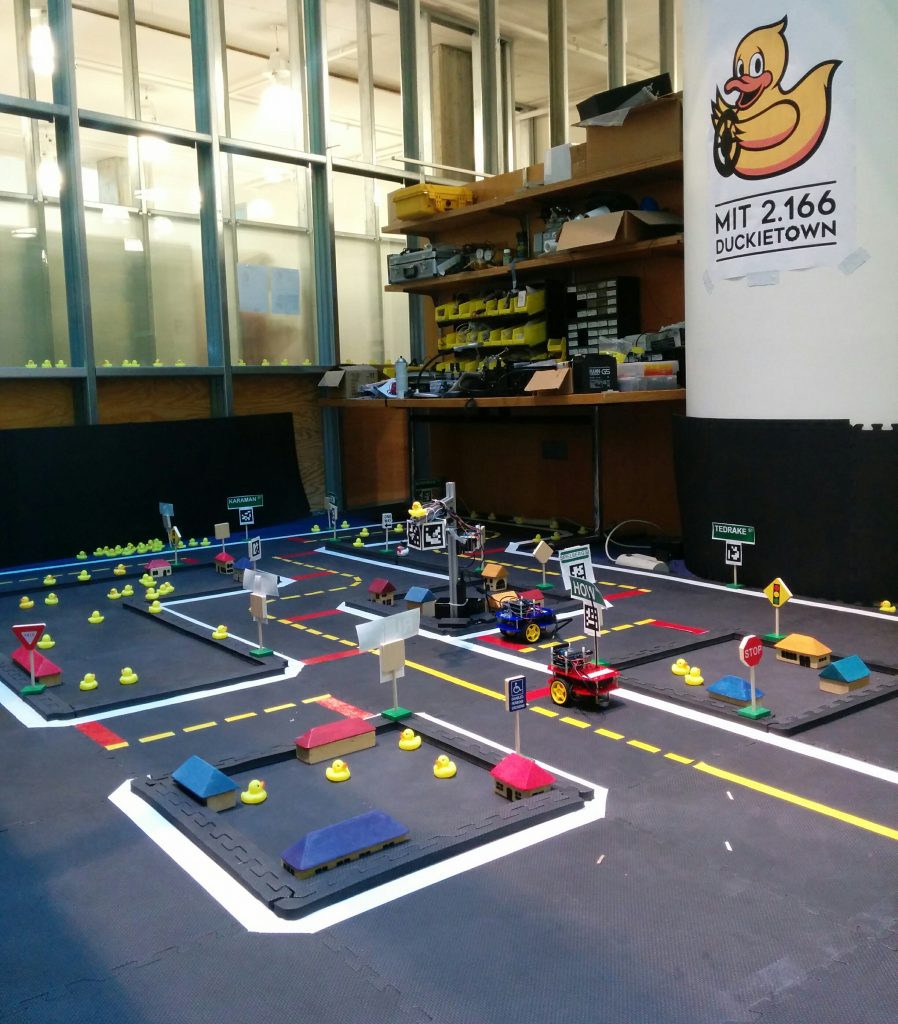
I left my parents visiting the rest of Boston and I started to go alone around the MIT departments, trying to open every door that I found in front of me.
While I was walking, I was looking through the laboratories windows and my attention was caught by an empty room -I mean with no humans inside 😀 ! – full of duckies and with a sort of track for cars on the floor.
What was this room about? What was the purpose of these duckies? I was very, very curious about it and had many questions, but there was no one in the lab!
Obviously I never give up, I absolutely believe that nothing is impossible so, every day, until my departure to the next leg of our trip, I continued to go around MIT passing in front of THAT lab hoping to find someone in it.
Finally one day I saw some people inside the lab doing something. I was really excited! I watched them from the window. I absolutely wanted to know what they were doing – one of them was soldering, another one was using duct tape. Suddenly they saw me and they invited into the lab! What an astonishment for me!
Immediately they asked me a lot of questions: why was a 14 year old roaming MIT alone, why was I so excited about that lab… Then one of them (I didn’t know his name) asked if I wanted to help build “Duckietown”. He told me about the project (at that time it wasn’t started yet) and he asked me about myself and the first robot I built. After an afternoon spent together, I discovered that this strange guy was Andrea Censi, one of the founders of the Duckietown project! Amazing!
Andrea proposed to me a challenge: I had to try to make my own Duckietown robot, a Duckiebot. Since it was a university project, I was able to follow the online tutorials and ask lots of questions to all the other Duckietown members on the communication forum, Slack. He had only one request of me: he told me that even though the robot was hard to build and program, I shouldn’t give up.
I was so happy that I immediately agreed. I was handed the robot kit, a list of various links and some Duckies 
Now it was my turn! I didn’t want to disappoint Andrea, so as soon as I arrived in Italy I put myself to work but, wow, building the Duckiebot was very hard! I spent an entire afternoon trying to comprehend just 4 rows of the tutorial. I began to ask questions on Slack and I tried, I tried and I tried again.
I never worked with Linux before so that was a completely new world for me. I started from the beginning, without knowledge at all but I worked for a few months until I received a message from Andrea: “Do you want to spend some time here, in Boston, working with us in Duckietown?” Of course I was willing, I couldn’t wait, it was an amazing proposal!
So I became a Duckietown Senior Tester at 15 years old and I spent almost all the summer inside the labs of MIT. My task was simplifying the university-level tutorial and making it accessible to the high-school students (like me 
Thanks to the help of Andrea and Liam (the other founder) I finally succeeded to program my robot: it was now able to drive autonomously in Duckietown. If felt like a dream come true!
Spending the summer in Duckietown at MIT allowed to me to discover a completely new world: I understood that education could be playful and that learning could be fun!
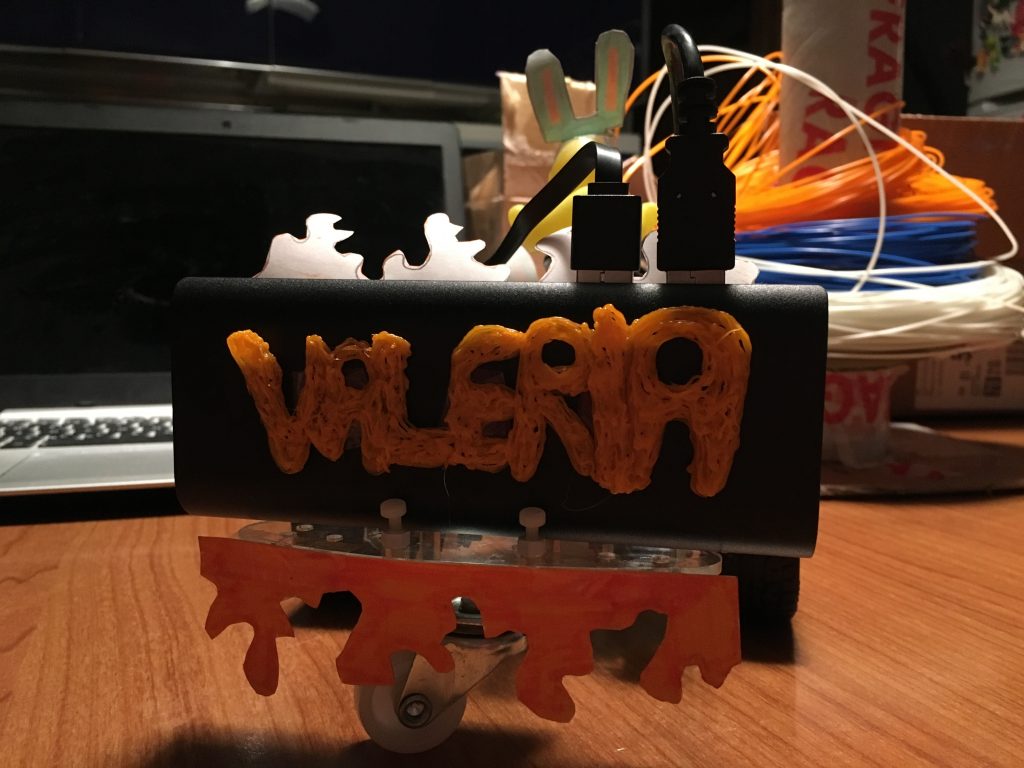

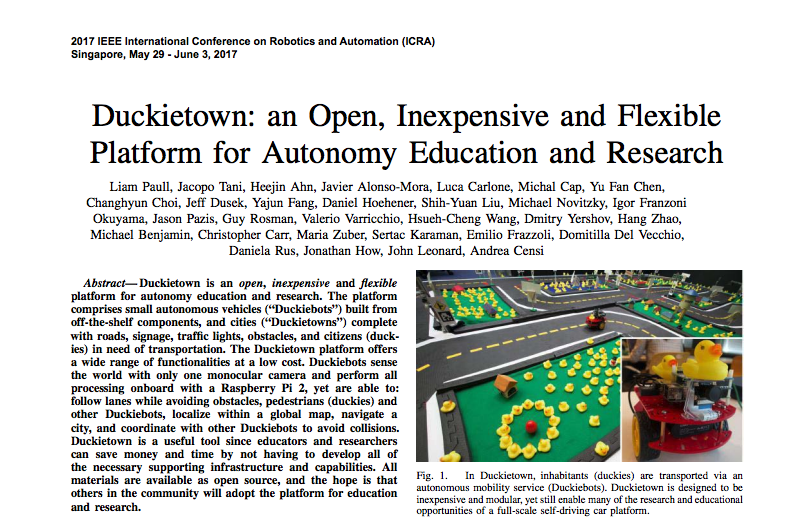
Duckietown: An open, inexpensive and flexible platform for autonomy education and research
- Title: Duckietown: An open, inexpensive and flexible platform for autonomy education and research
- Authors: Liam Paull; Jacopo Tani; Heejin Ahn; Javier Alonso-Mora; Luca Carlone; Michal Cap; Yu Fan Chen; Changhyun Choi; Jeff Dusek; Yajun Fang; Daniel Hoehener; Shih-Yuan Liu; Michael Novitzky; Igor Franzoni Okuyama; Jason Pazis; Guy Rosman; Valerio Varricchio; Hsueh-Cheng Wang; Dmitry Yershov; Hang Zhao; Michael Benjamin; Christopher Carr; Maria Zuber; Sertac Karaman; Emilio Frazzoli; Domitilla Del Vecchio; Daniela Rus; Jonathan How; John Leonard; Andrea Censi
- Published: 2017 IEEE International Conference on Robotics and Automation (ICRA)
Duckietown: An open, inexpensive and flexible platform for autonomy education and research
Did you find this interesting?
Read more Duckietown based papers here.

